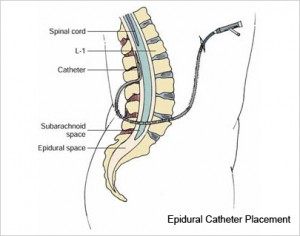Spinal or Epidural Catheters
What is a Spinal or Epidural Catheter?
An epidural catheter is a very fine plastic catheter (tube), which is placed through the skin into the epidural space within your spinal canal. This temporary catheter is left in place for a defined period of time; several days for most types of surgical pain and up to 6 weeks for certain types of chronic pain. The catheter allows access to the epidural space to inject medication such as local anesthetics and/or narcotics for relief of pain. Temporary epidural catheters are used for short-term treatment of painful conditions that require pain control for intensive physical therapy and/or joint mobilization. They are also used prognostically for trials of spinal medications prior to placement of permanent implanted ports or programmable pumps.
With an epidural catheter, patients can obtain pain relief within minutes. It may, however, take a few days to adjust the dose for the optimal pain relief. The catheter gives your Pain Management physician the ability to adjust the medication and determine the appropriate dosage.
Procedure:
 The temporary epidural catheter placement is considered to be a safe medical procedure which is performed in in the hospital, usually in the operating room. As with any procedure, it has risks as well as benefits. To minimize the chance of complications, the UPC physicians and staff will provide with instructions before and after your catheter is placed. Among those may the following:
The temporary epidural catheter placement is considered to be a safe medical procedure which is performed in in the hospital, usually in the operating room. As with any procedure, it has risks as well as benefits. To minimize the chance of complications, the UPC physicians and staff will provide with instructions before and after your catheter is placed. Among those may the following:
- You will be asked to not eat or drink anything for (8) eight hours prior to the procedure.
- Following placement of the temporary epidural catheter, you will be admitted to the hospital for approximately (5) five days for observation. A responsible adult driver should accompany you to and from the hospital.
If the catheter is meant to stay in place for up to 6 weeks, the insertion of the catheter will be performed in sterile setting in the operating room. An intravenous (IV) line will placed so that the doctor can administer medication to help minimize your discomfort and anxiety. You will be asked to either sit or lie on your side on the bed. After cleaning a small patch of skin along your spine, a local anesthetic will be administered into the skin to decrease any pain associated with the placement of the catheter. A small needle will then be used to locate the epidural space, and a catheter will be threaded through the needle. The needle will then be withdrawn and a second patch of skin will be anesthetized with local anesthetics. X-ray equipment may be used to aid in the appropriate placement of the catheter. A similar needle will be placed in the second spot in order to bring the catheter from the middle of your back to the side.This allows the catheter to be tunneled underneath the skin for a distance of about four to five inches in order to provide stability. Two or three stitches may be placed to secure the catheter. The catheter is then covered with sterile dressing and taped to the skin of your back.
The procedure itself is brief, and associated with minimal discomfort.
Once the catheter is placed, it will be injected with medication, usually a local anesthetic and/or a narcotic, and checked to be sure it is functioning correctly by observing for signs of pain relief from the medications, as well as development of numbness from the local anesthetic. You will then be monitored for 20 to 40 minutes by a nurse and a Pain Management physician, which is usually done in the Recovery Room.
If there are no signs of problems, you will be ready to leave the recovery area and return to your hospital room.Your epidural catheter will be dosed with medications on continuous basis based on the determination of the Pain Management physician. Additionally the Infusion Device wil be programmed so that patients can self-administer small intermittant doses of medication for adjuctive relief.
The catheter is designed for short term use only and is normally removed prior to discharge from the hospital. In some cases patients are discharged home with the catheter and are managed at home with the assistance of a home nursing agency.
Post-procedure instructions:
These will be provided for you, in further detail, by the nurse, prior to your discharge from the hospital.
Before going home, the catheter will be removed and the insertion site will be dressed with gauze dressing.
If you go home with the temporary epidural catheter in place, the catheter insertion site will be dressed with a clear plastic dressing. This allows you to be able to monitor the site for any signs of infection such as redness or swelling. Your home nursing agency will change the dressing as ordered and also inspect the site for any evidence of infection or problems.
If you have any questions after the procedure, the Pain Management staff is on call 24 hours a day, seven days a week. During normal business hours, you can reach either the nurse or physician by calling (312) 942-6631. After hours, the physician on call can be reached through the hospital page operator (312) 942-5000, pager #2-7926 or by contacting the Pain Fellow on-call.
